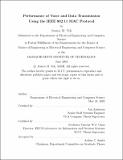Performance of voice and data transmission using the IEEE 802.11 MAC Protocol
Author(s)
Yeh, Jessica M. (Jessica Minjade), 1979-
DownloadFull printable version (511.7Kb)
Other Contributors
Massachusetts Institute of Technology. Dept. of Electrical Engineering and Computer Science.
Advisor
Jon Anderson and Vincent W.S. Chan.
Terms of use
Metadata
Show full item recordAbstract
The IEEE 802.11 wireless LAN standard attempts to provide high throughput and reliable data delivery for stations transmitting over a lossy, wireless medium. To efficiently allocate resources for bursty sources, the 802.11 Medium Access Control (MAC) sublayer uses a type of Carrier Sense Multiple Access with Collision Avoidance (CSMA/CA) protocol called the Distributed Coordination Function (DCF). The MAC protocol also includes an optional polling scheme called the Point Coordination Function (PCF) to deliver near-isochronous service to stations. This thesis analyzes the performance of these two medium access mechanisms under real-time voice and asynchronous data transmissions. Using analytical and simulative methods, the efficiency and capacity of the 802.11 protocol is determined for each type of traffic individually, as well as for a traffic mix of the two types. It is shown that the upper bound of data efficiency for DCF is 65.43% percent when transmitting maximum-sized IP packets at 11 Mbps. Furthermore, due to the difference in packet size of the two traffic types, for each additional GSM voice call (approximately 11 kbps including voice activity) to be supported using DCF, the non-real-time traffic load must decrease by approximately 250 kbps. Voice receives very little real-time Quality of Service (QoS) when using DCF to contend with constantly sending data stations. In order for 802.11 to provide real-time QoS for voice packets despite all levels of asynchronous traffic data load, the PCF mechanism can be used. By only using PCF for voice traffic, voice packets will always take priority over asynchronous data packets and receive the required real-time QoS.
Description
Thesis (M.Eng.)--Massachusetts Institute of Technology, Dept. of Electrical Engineering and Computer Science, 2002. Includes bibliographical references (p. 99-100). This electronic version was submitted by the student author. The certified thesis is available in the Institute Archives and Special Collections.
Date issued
2002Department
Massachusetts Institute of Technology. Department of Electrical Engineering and Computer SciencePublisher
Massachusetts Institute of Technology
Keywords
Electrical Engineering and Computer Science.